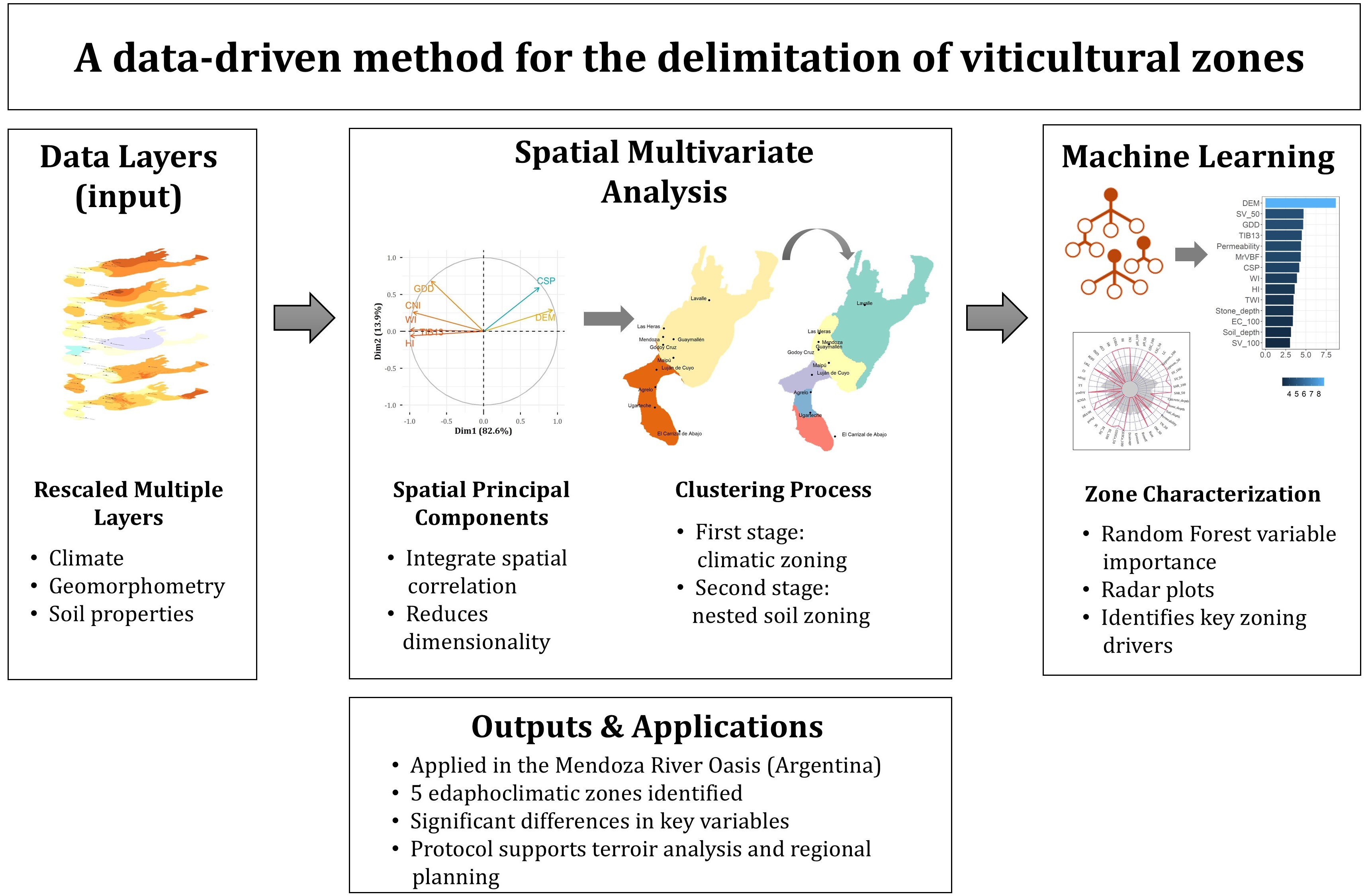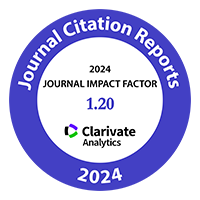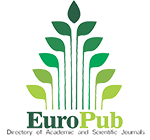Data-driven Method for the Delimitation of Viticultural Zones: Application in the Mendoza River Oasis, Argentina
Keywords:
spatial clustering, edaphoclimatic zoning, zoning driversAbstract

In viticulture, understanding the spatial variability of natural factors influencing vineyard potential is essential for terroir characterization. In the present study, we present a data-driven protocol that integrates climate, geomorphology, and soil data to delineate viticultural zones. The method combines spatial layers with statistical tools to partition a region into areas with similar characteristics. The protocol comprises: 1) rescaling multiple spatial data layers, 2) applying spatial multivariate analysis to group spatial units, and 3) using machine-learning algorithms to identify key zoning drivers. The approach was applied to the Mendoza River oasis in Argentina. Climate and geomorphology layers were used first, as they varied at a broader spatial scale than soil data. Two climatic zones were identified, mainly differentiated by elevation and thermal indices. Subsequent soil-based zoning within each climatic zone revealed five distinct edaphoclimatic zones. These zones showed statistically significant differences in environmental variables and exhibited spatial coherence aligned with landscape features. Results showed that this protocol facilitates the integration of diverse data sources and supports a deeper understanding of the uniqueness of vineyard zones in wine-producing regions.
Highlights:
- A data-driven protocol integrates climate, soil, and geomorphology for vineyard zoning.
- Spatial principal components and clustering ensure geographically coherent zones.
- Nested zoning distinguishes broad climatic patterns and finer edaphic variability.
- Random Forest identifies key environmental drivers defining each viticultural zone.
- The method supports terroir analysis, vineyard management, and regional planning.
Downloads
References
Albornoz, E. M., Kemerer, A. C., Galarza, R., Mastaglia, N., Melchiori, R., & Martínez, C. E. (2018). Development and evaluation of an automatic software for management zone delineation. Precision Agriculture, 19(3), 463-476. https://doi.org/10.1007/s11119-017-9530-9
Amerine, M. A., & Winkler, A. J. (1944). Composition and Quality of Musts and Wines of California Grapes. Hilgardia, 15(6), 493-675. https://doi.org/10.3733/hilg.v15n06p493
Biss, A. J. (2020). Impact of vineyard topography on the quality of Chablis wine. Australian Journal of Grape and Wine Research, 26(3), 247-258. https://doi.org/10.1111/ajgw.12433
Bramley, R., Ouzman, J., & Trought, M. C. T. (2020). Making sense of a sense of place: precision viticulture approaches to the analysis of terroir at different scales. OENO One, 54(4), 903-917. https://doi.org/10.20870/oeno-one.2020.54.4.3858
Bramley, R., & Gardiner, P. S. (2021). Underpinning terroir with data: a quantitative analysis of biophysical variation in the Margaret River region of Western Australia. Australian Journal of Grape and Wine Research, 27(4), 420-430. https://doi.org/10.1111/ajgw.12491
Bramley, R., Ouzman, J., Sturman, A. P., Grealish, G. J., Ratcliff, C. E. M., & Trought, M. C. T. (2023). Underpinning Terroir with Data: Integrating Vineyard Performance Metrics with Soil and Climate Data to Better Understand Within-Region Variation in Marlborough, New Zealand. Australian Journal of Grape and Wine Research, 1-23. https://doi. org/10.1155/2023/8811402
Breiman, L. (2001). Random Forests. Machine Learning, 45(1), 5-32. https://doi. org/10.1023/A:1010933404324
Cavagnaro, M., Pappalardo, C., & Dalmasso, J. (2023). Caracterización climática de regiones vitivinícolas de Argentina. Provincia Mendoza. https://caracterizacion-fisico-ambiental-coviar.hub. arcgis.com/
Córdoba, M., Balzarini, M., Bruno, C., & Costa, J. L. (2012). Análisis de componentes principales con datos georreferenciados. Una aplicación en agricultura de precisión. Revista de la Facultad de Ciencias Agrarias. Universidad Nacional de Cuyo, 44(1), 27-39.
Córdoba, M., Paccioretti, P., & Balzarini, M. (2024). Ofemeantest: On Farm Experimentation Mean Test. R package version 0.0.900. https://github.com/PPaccioretti/ofemeantest
de Sosa, L. L., Navarro‐Fernández, C. M., Panettieri, M., Madejón, P., Pérez‐de‐Mora, A., & Madejón, E. (2023). Application of seaweed and pruning residue as organic fertilizer to increase soil fertility and vine productivity. Soil Use and Management, 39(2), 794-804. https://doi. org/10.1111/sum.12882
Ferretti, C. G. (2020). A new geographical classification for vineyards tested in the South Tyrol wine region, northern Italy, on Pinot Noir and Sauvignon Blanc wines. Ecological Indicators, 108, 105737. https://doi.org/10.1016/j.ecolind.2019.105737
Ferro, M. V., & Catania, P. (2023). Technologies and Innovative Methods for Precision Viticulture: A Comprehensive Review. Horticulturae, 9(3), 399. https://doi.org/10.3390/ horticulturae9030399
Fox, E. W., Ver Hoef, J. M., & Olsen, A. R. (2020). Comparing spatial regression to random forests for large environmental data sets. PLOS ONE, 15(3), e0229509. https://doi.org/10.1371/ journal.pone.0229509
Ghilardi, F., Virano, A., Prandi, M., & Borgogno-Mondino, E. (2023). Zonation of a Viticultural Territorial Context in Piemonte (NW Italy) to Support Terroir Identification: The Role of Pedological, Topographical and Climatic Factors. Land, 12(3), 647. https://doi.org/10.3390/ land12030647
Hall, A., & Jones, G. V. (2010). Spatial analysis of climate in winegrape-growing regions in Australia. Australian Journal of Grape and Wine Research, 16(3), 389-404. https://doi.org/10.1111/ j.1755-0238.2010.00100.x
Huglin, P. (1983). Possibilites d’ appreciation objective du milieu viticole. Bulletin de l’OIV, 56, 823-833.
INV. (2024). Informe anual de cosecha y elaboración 2024.
Irimia, L. M., Patriche, C. V., & Quénol, H. (2014). Analysis of viticultural potential and delineation of homogeneous viticultural zones in a temperate climate region of Romania. OENO One, 48(3), 145. https://doi.org/10.20870/oeno-one.2014.48.3.1576
Jarvis, C., Barlow, E., Darbyshire, R., Eckard, R., & Goodwin, I. (2017). Relationship between viticultural climatic indices and grape maturity in Australia. International Journal of Biometeorology, 61(10), 1849-1862. https://doi.org/10.1007/s00484-017-1370-9
Jolliffe, I. T., & Cadima, J. (2016). Principal component analysis: a review and recent developments. Philosophical Transactions of the Royal Society A: Mathematical, Physical and Engineering Sciences, 374(2065), 20150202. https://doi.org/10.1098/rsta.2015.0202
Jones, G. V., White, M. A., Cooper, O. R., & Storchmann, K. (2005). Climate Change and Global Wine Quality. Climatic Change, 73(3), 319-343. https://doi.org/10.1007/s10584-005-4704-2
Kuhn, & Max. (2008). Building Predictive Models in R Using the caret Package. Journal of Statistical Software, 28(5), 1-26. https://doi.org/10.18637/jss.v028.i05
Lanyon, D. M., Hansen, D., & Cass, A. (2004). The effect of soil properties on vine performance. CSIRO Land and Water Technical Report N°. 34/04.
Malone, B. P., McBratney, A. B., Minasny, B., & Laslett, G. M. (2009). Mapping continuous depth functions of soil carbon storage and available water capacity. Geoderma, 154(1-2), 138-152. https:// doi.org/10.1016/j.geoderma.2009.10.007
McBratney, A. B., Mendonça Santos, M. L., & Minasny, B. (2003). On digital soil mapping. Geoderma, 117(1-2), 3–52. https://doi.org/10.1016/S0016-7061(03)00223-4
Morlat, R., & Bodin, F. (2006). Characterization of Viticultural Terroirs using a Simple Field Model Based on Soil Depth – II. Validation of the Grape Yield and Berry Quality in the Anjou Vineyard (France). Plant and Soil, 281(1-2), 55-69. https://doi.org/10.1007/s11104-005- 3769-z
Mullins, M. G., Bouquet, A., & Willians, L. E. (1992). Biology of the Grapevine. Cambridge University Press.
Nakazawa, M. (2023). fmsb: Functions for Medical Statistics Book with some Demographic Data. https:// minato.sip21c.org/msb/
Paccioretti, P., Córdoba, M., Giannini-Kurina, F., & Balzarini, M. (2024). paar: Precision Agriculture Data Analysis. R package version 1.0.1, https://CRAN.R-project.org/package=paar
Piraino, S.; Roig, F. A. 2024. Landform heterogeneity drives multi-stemmed Neltuma flexuosa growth dynamics. Implication for the Central Monte Desert forest managemen. Revista de la Facultad de Ciencias Agrarias. Universidad Nacional de Cuyo. Mendoza. Argentina. 56(1): 26-34. DOI: https://doi.org/10.48162/rev.39.120
Pracilio, G., Smettem, K. R. J., Bennett, D., Harper, R. J., & Adams, M. L. (2006). Site assessment of a woody crop where a shallow hardpan soil layer constrained plant growth. Plant and Soil, 288(1-2), 113-125. https://doi.org/10.1007/s11104-006-9098-z
Puscama, F., Gil, R., & Berli, F. (2025). Impact of intra-vineyard soil heterogeneity on Malbec. Vine growth, yield and wine elemental composition and sensory profile. Revista de la Facultad de Ciencias Agrarias. Universidad Nacional de Cuyo, 57(1), 1-18.
R Core Team. (2024). R: A Language and Environment for Statistical Computing. R Foundation for Statistical Computing, Vienna, Austria. R Foundation for Statistical Computing. https:// www.R-project.org/
Retallack, G. J., & Burns, S. F. (2016). The effects of soil on the taste of wine. GSA Today, 26(5), 4-9. https://doi.org/10.1130/GSATG260A.1
Straffelini, E., Carrillo, N., Schilardi, C., Aguilera, R., Estrella Orrego, M. J., & Tarolli, P. (2023). Viticulture in Argentina under extreme weather scenarios: Actual challenges, future perspectives. Geography and Sustainability, 4(2), 161-169. https://doi.org/10.1016/j. geosus.2023.03.003
Tonietto, J., & Carbonneau, A. (2004). A multicriteria climatic classification system for grape-growing regions worldwide. Agricultural and Forest Meteorology, 124(1-2), 81-97. https://doi. org/10.1016/j.agrformet.2003.06.001
Vallone, R., Olmedo, G., Maffei, J., Morábito, J., Mastrantonio, l., Lipinski, V., & Filippini, M. (2007). Mapa de Aptitud de suelos con fines de Riego y de riesgo de contaminación edáfica de los Oasis Irrigados de la Provincia de Mendoza. FCA-DGI-OEI.
Vallone, R., Moreiras, S., Cáceres, M., Arzalluz, I., Zuin, J., Martín, T., & Corvalán, F. (2023). Caracterización geológica, geomorfológica y edafológica de zonas vitícolas argentinas. Provincia Mendoza. Oasis Norte. https://caracterizacion-fisico-ambiental-coviar.hub.arcgis.com/
Van Leeuwen, C., Roby, J. P., Pernet, D., & Bois, B. (2010). Methodology of soil-based zoning for viticultural terroirs. Bulletin de l’OIV, 83(947), 0-13.
Vaudour, E., Carey, V. A., & Gilliot, J. M. (2010). Digital zoning of South African viticultural terroirs using bootstrapped decision trees on morphometric data and multitemporal SPOT images. Remote Sensing of Environment, 114(12), 2940-2950. https://doi.org/10.1016/j. rse.2010.08.001
Visconti, F., López, R., & Olego, M. Á. (2024). The Health of Vineyard Soils: Towards a Sustainable Viticulture. Horticulturae, 10(2), 154. https://doi.org/10.3390/horticulturae10020154

Downloads
Published
How to Cite
Issue
Section
License
Copyright (c) 2018 Revista de la Facultad de Ciencias Agrarias UNCuyo

This work is licensed under a Creative Commons Attribution-NonCommercial-ShareAlike 3.0 Unported License.
Aquellos autores/as que tengan publicaciones con esta revista, aceptan las Políticas Editoriales.












.jpg)




